- Influences of polymers on the properties of cement-sodium silicate grouts with a high water-binder ratio
Rongfeng Lin, Lei Yang*, Shucai Li, Rangjie Li, Xiangchao Sheng and Guangxiao Song
Geotechnical & Structural Engineering Research Center, Qianfoshan Campus, Shandong University, Lixia District, Jinan City, Shandong Province, China
This study investigates the
influence of redispersible latex powder and hydroxy propyl methyl cellulose on
the physical and mechanical properties of cement-sodium silicate grouts with a
high W/B ratio. The rheological properties, setting time, compressive strength,
autogenous shrinkage sulfate attack resistance and permeability of the grouts
were assessed and compared. The microstructures were investigated in terms of
crack development. The results show that satisfactory properties and
durability, such as an initial setting time extension of 20~55%, an autogenous
shrinkage reduction of 0.332~1.21‰, and a permeability addition of
0.1–0.4 MPa, were obtained in cement-sodium silicate grouts with the
addition of two polymers. The flexural strength of cement-sodium silicate
grouts with redispersible latex powder was improved after curing in water and
sulfate attack by 3 wt% sodium sulfate. However, the addition of two polymers
reduced the compressive strength of all grouts except for the redispersible
latex powder content of 3%. These research results can provide a technical
reference for grouting material selection and mixing ratio adjustment.
Keywords: Cement sodium silicate grout, Redispersible latex powder, Hydroxy propyl methyl cellulose, Physical and mechanical properties, Microstructure
Cementitious grouts are often used for geological
strengthening and water control (GSWC) in grouting reinforcement engineering based
on cost, application technology and environmental
conservation. For resisting dilution and
scour of moving water during grout injection, rapid
setting times and accelerators are required [1, 2]. Sodium silicate solution
(SSS) is frequently used as an accelerator because of its efficiency and
storage and handling benefits to promote agglomeration and
solidifi-cation of
cement grout against gushing water [3-6]. The advantage of cement-sodium
silicate (CS) grouts lies in their short gelation time and high compressive
strength in the early stage, so they are widely used for strengthening weak
strata and plugging leaks. Previous studies on CS grouts have mainly focused on
the influence of the change of the double liquid volume ratio or the addition
of admixtures and additives on the physical and mechanical properties [7-11].
When CS grouts are in the condition of water enrichment, sodium hydroxide and
other substances are easily dissolved, which will easily cause alkali pollution
to groundwater and the environment. Moreover, the alkalinity decrease of the
concretion can easily lead to the decomposition of hydrated calcium silicate
gel and other substances and ultimately lead to structural destruction of the
concretion [12, 13]. When the solidified body of CS grouts is in
a dry condition, the silica gel will dehydrate, which will
result in shrinkage and cracking [14].
Adding a small amount of polymer to the cement mixture can
significantly enhance the performance of the final material, which is called
polymer-modified cement-based material (PMC) [15]. Polymer can
signifi- cantly
improve the tensile strength, flexural strength, flexibility, compactness and
durability of cement-based composite material and has a wider adaptability to
engineering compared with ordinary cement-based material slurry [16]. PMC has
good flexibility and bonding properties, which can lap the cracks caused by
shrinkage between particles and prevent the occurrence of cracks [17].
To date, polymers have become
an important com- ponent of
cement-based materials. However, most studies focus on the effects of polymers
on mortar and concrete properties [16-20]; the combined effects of polymer and
CS grouts have received less attention, especially concerning high water-to-binder (W/B)
ratios. This study experimentally
investigated the effects of redispersible latex powder (RLP) and hydroxy propyl
methyl cellulose (HPMC) on the
physical and mechanical properties of CSG with a high W/B ratio, considering
varied mixing amounts of polymers, and performed a microanalysis based on
scanning electron microscopy (SEM) to analyze the microstructure. According to
the main results of this study, some suggestions are also proposed for further studies
and engineering applications.
Experimental
materials
In this study, ordinary Portland cement (OPC) with the
strength grade of P. O 42.5 according to the China National Standards
GB175-2007 was used, and its chemical composition, which was provided by the
manufacturer, is listed in Table 1. A commercial SSS was adopted as the
accelerator for the grout. The density was 1.26 g/cm3, and the
concentration and modulus values (Ms, SiO2 to Na2O ratio)
of SSS used were 25 wt% and 2.6, respectively. In addition, two main types
of polymers with a solid content of 99%, including RLP, which is based on the
copolymer of vinyl acetate and ethylene, and HPMC, which has a viscosity of
100,000, were used.
Based on practical engineering and commonly used mixtures
of CS grouts, the W/B ratio of the cement slurry was 0.8, and the designed
volume ratio (VR, OPC paste to sodium silicate) was 3. During the experi- ment, the mixing amount of RLP and HPMC was
changed to investigate their effects on the physical and mechanical properties
of CS grouts, while the amounts of other components remained
constant. To conveniently assess and compare the results, the
mix proportions were converted and expressed in Table 2, in which the data
denote the proportions relative to the mass of OPC.
Mix
design and specimen preparation
CS grouts adopt a dual-liquid grouting process. OPC slurry
and SSS are used as two liquids, which are then mixed and injected into the
formation. OPC slurry with or without polymer is used as the A liquid, and
alkaline SSS is used as the B liquid in this paper. The OPC powder, polymer
powder and water were fully blended for 240 s in a cement slurry mixer in
accordance with the predetermined W/B ratio. Then, a certain volume of SSS was
poured into the mixer and blended with the prepared OPC slurry for 5 s to
obtain fresh CS grouts. The stirring rate was approximately 285 r/min to
ensure thorough mixing of the components. After stirring, the fresh slurry was
cast into molds and kept in the molds for 2 h to avoid breaking when the
specimen was exposed to air for a long time. The molds used to create the
following specimens: a height of 40 mm, an inside diameter at the bottom
of 70 mm, and an inside diameter at the top of 60 mm conical ring for
final setting time; a 40×40×40 mm cube for the compressive strength test;
a 25×25×280 mm prism (with two copper measuring heads embedded 15 mm
at both ends) for the shrinkage test; a truncated cone shape with a
70 mm top diameter, an 80 mm bottom diameter and a
30 mm height for the penetration test; and a 40×40×160 mm prism for
the rapid sulphate resistance test.
Then, the specimens were demolded and cured in water at a
temperature of 20±2 oC for a certain period because
the specimens that were exposed to air suffered
cracking and breaking (Fig. 1). Three specimens were made for each mixture to
reduce deviations. The rapid stirring time used for the CSG was mainly because
of their rapid setting time, which might lead to layered gelation of the
specimens without adequate time for casting.
Methods
The initial setting time cannot be obtained by using the
method of the ASTM C191-13 standard because the real W/B ratio of the proposed
CS grouts was 1.15 and was rapid-setting. However, the final setting of the CS
grouts adopts the method of this standard for testing. The initial setting time
is usually determined by the “pour cup method”. A and B liquid that had been
weighed were placed in two plastic cups. Liquid A was added to liquid B, the
timer was started, and then the liquid was poured back into the A cup and
repeated at the specified frequency. The initial setting time was the time at
which the surface of the CS grouts remained at 45o once the plastic
cup was straightened [9]. The gelatinized CS grouts with inclined surfaces in
plastic cups are shown in Fig. 2a.
Although the incorporation of the polymer might prolong
the setting time of the CS grouts, the slurry loses fluidity in only a few tens
of seconds. The time and accuracy requirements required for the viscometer to
test the rheological properties of the slurry cannot be met. Therefore, the
yield stress and plastic viscosity of OPC slurry incorporating RLP and HPMC
were tested to illustrate the effect of the polymers on the
rheological properties. The fluidity was determined by a truncated
cone die according to the national standard (GB/T 8077-2012) of China, and it
was conducted using smooth copper cones with dimensions of 60 mm in
height, 36 mm in bottom diameters and 60 mm in top diameters. The
mixed A liquid was injected into the truncated cone die, and the truncated cone
die was lifted to determine the maximum diameter of the slurry flowing
freely on the glass plane (Fig. 2b). The rheological
characteristics were tested with a VISCO-RM100 from LAMY RHEOLOGY (Fig. 2c).
The slurry was mixed evenly and then moved to the test container. The shear
stresses at speeds of 5, 20, 30 and 50 rpm were tested in 30 seconds,
and then plastic viscosity and yield stress were obtained through data
analysis.
The compressive strength test was conducted according
to ASTM Standard C942-15. Strength at 3, 7, 14, 28 and 56 d was tested to
determine the development of compressive strength.
The period was 28 d for the penetration test according
to the industrial standard (JGJ/T 70-2009) of China.
The shrinkage test was performed after demolding according
to ASTM C157. The lengths (Li) at 1, 2, 3, 7, 14, 28, 35, 42, 49, 56 and
63 d were measured to determine the development of shrinkage with the length
change rate (LCR) using the standard prescribed formula: LCR = (the
initial lengths- Li)/250. However, the curing method of the specimen was
changed to water curing since the CS grouts for GSWC in projects were always
immersed in water and seldom suffered drying-wetting cycles. Additionally,
specimens with a high W/B ratio, as shown in Fig. 1, were easily cracked and unable
to mold in the air. Hence, the volume stability of the CS grouts was performed
through autogenous shrinkage instead of natural drying shrinkage
in this paper, which had been previously used in the literature [6]. Finally,
the microstructures of the 28 d hardened CS grouts were investigated using SEM
(Thermo Fisher 250 from FEI). The appearance of crystals was examined under a
magnification of 2000 times.
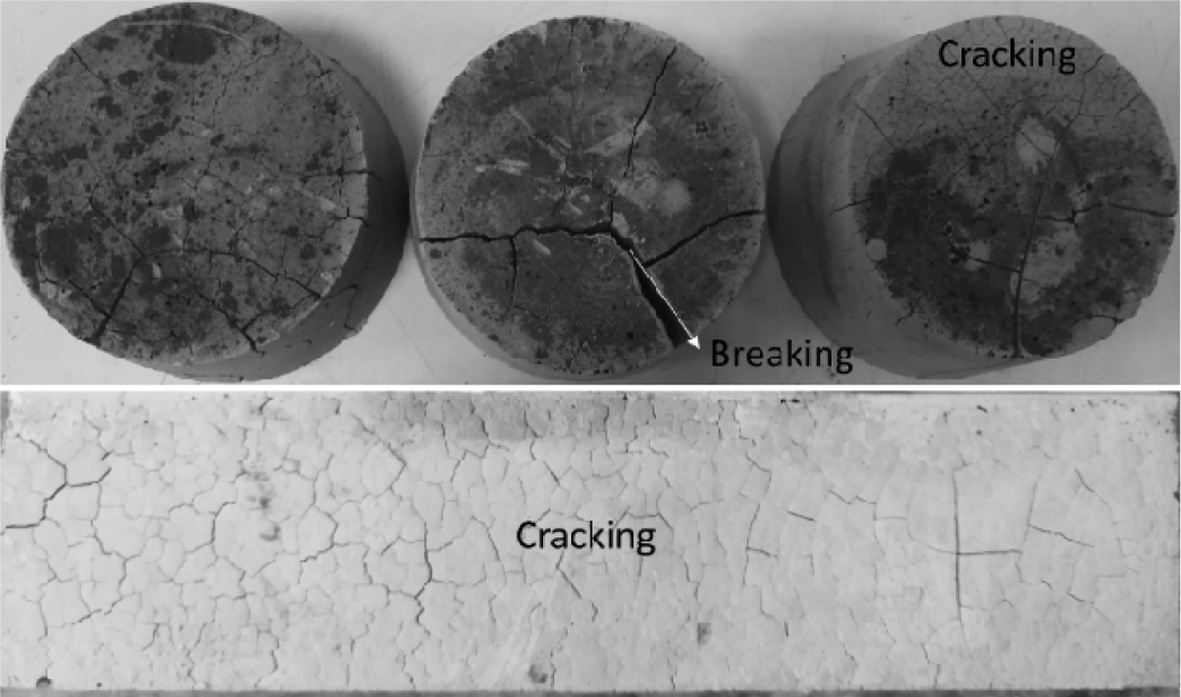
|
Fig. 1 Cracking and breaking of specimens in the air during the curing process. |
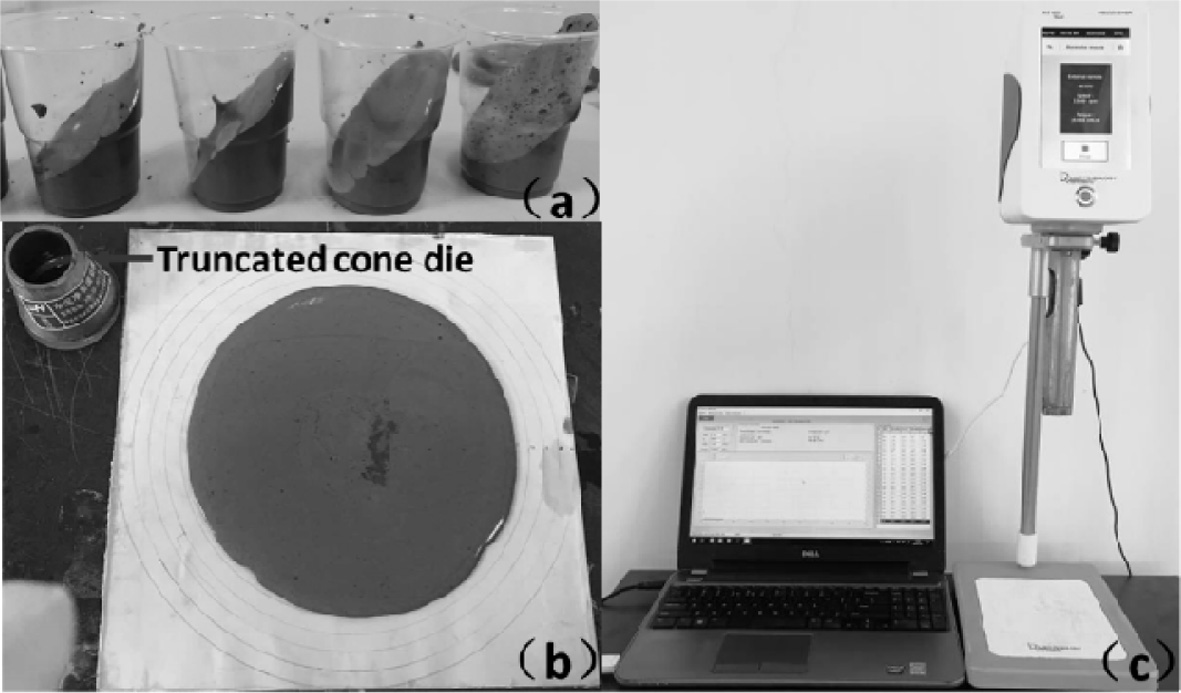
|
Fig. 2 The experimental instruments for the (a) setting time test, (b) fluidity test and (c) viscosity test. |
Rheological
properties
The rheological properties of cement slurry with and
without polymers with a W/B ratio of 0.8 can be approximated by the Bingham
model [21], which can be characterized by yield stress and plastic viscosity.
It can be seen from Fig. 3 that when the content of RLP is increased from 3% to
15%, the yield stress and plasticity viscosity of the slurry show an increasing
trend, the yield stress increases by 79~319%, and the growth amplitude of the
plastic viscosity reaches 29~175%. RLP has certain water-reducing and
air-entraining effects [16, 18]. When the mixing amount of RLP is less, the
introduction of a proper amount of bubbles and the formation of
the emulsion by dissolving RLP during the mixing of slurry
will result in the “rolling ball” and lubricating effect, which will increase
the fluidity of the slurry. However, the introduction of more than a certain
amount of bubbles will reduce the fluidity of the slurry. RLP will absorb more
free water with the increase of the mixing amount, which will lead to the
reduction of the fluidity and the increase of the cohesion of the slurry.
Therefore, the yield stress and plastic viscosity tend to increase with
increasing dosage of RLP. This also explains why the grout
fluidity first increases and then decreases.
When the amount of HPMC increases from 1‰ to 3‰, the slope
of the yield stress and plastic viscosity curves increases more obviously
compared with the effect of RLP. The increase amplitude of yield stress reaches
259~449%, and the increase amplitude of plasticity viscosity reaches 77~141%.
This is mainly because the hydroxyl group and the oxygen atom on the ether bond
of the HPMC molecule form the hydrogen bond with the water molecule, which will
lead to the reduction of the free water in the slurry. The polymer’s long chain
will adsorb and fix more water with the increase of the mixing amount, which
leads to the weakening of the lubrication effect of the cement particles and
the increase of the frictional force. Therefore, the yield stress and plastic
viscosity of the slurry increase, and the fluidity of the slurry decreases.
Setting
time
As shown in Fig. 4, the setting time of CS grouts greatly
affects their diffusion distance in strata and the anti-dilution performance in
moving water. When the amount of RLP increases from 3% to 15%, the initial and
final setting time of the slurry show an increasing trend, but the change of
initial setting time is smaller, and the final setting time is up to 44% longer
than that of the blank group (CS-0). When the dosage of HPMC increases from 1‰
to 3‰, the initial setting time is 20~55% longer than that of the blank group,
and the final setting time is prolonged 67~78%. Polymer particles form
emulsions in water that increase the viscosity of the slurry, but this has a
very weak effect on the reaction of SSS and calcium hydroxide (CH) formed by
the hydration of cement. The polymer particles in the emulsion are adsorbed on
the surface of hydration products and nonhydrated cement particles that hinder
the contact between the SSS and CH produced by the hydration of cement, thus
delaying the hydration of CS grouts. In addition, the high amount of polymer
has a more serious effect on the setting time of the slurry.
Compressive
strength
As shown in Fig. 5, the compressive strengths of CS grouts
show a trend of increasing first and then decreasing with the increase of the
mixing amount, which is similar to other results noted in the literature [19].
The peak value appears at the dosage of 3%. The compressive strengths increase
by 12~18% from 7 d to 56 d before the peak compared with the blank group. Then,
the compressive strengths show a decreasing trend. With the amount of RLP
ranging from 6% to 15%, compressive strengths at 3 d reduce the range from 10%
to 25%, compressive strengths at 7 d reduce the range from 6% to 28%,
compressive strengths at 14 d reduce the range from 2% to 25%, compressive
strengths at 28 d reduce the range from 6% to 29%, and compressive strengths at
56 d reduce the range from 8% to 26% compared with the blank group.
The compressive strengths of CS grouts can be affected by
the following factors. First, some RLP particles fill smaller pores, which will
make the material more compact and improve the compressive strengths.
Second, the polymer forms thin films between cement
particles to increase the flexibility, which has a negative impact on the
compressive strength. Finally, RLP introduces a large number of bubbles, which
will reduce the strength. When RLP is mixed with a low amount (3%), the
compressive strength is improved because of the filling effect of RLP particles
on smaller pores. With the increase of the mixing amount, the compressive
strength decreases gradually due to the increasing
air-entraining content and monolithic flexibility.
Fig. 6 shows the compressive strengths of specimens with
different amounts of HPMC. The compressive strengths of the CS grouts decrease
gradually with increasing dosage of HPMC. When the dosage of HPMC
increased from 1‰ to 3‰, compressive strengths at 3 d
reduced the range from 18% to 27%, com-
pressive strengths at 7 d reduced the range from 23% to 29%, compressive
strengths at 14 d reduced the range from 12% to 23%, compressive strengths at
28 d reduced the range from 10% to 24%, and compressive strengths at 56 d
reduced the range from 9% to 21% compared with the blank group. The influencing
factors of HPMC are similar to those of RLP on the compressive strength.
However, the molecular structure of HPMC has a large number of hydrophilic
groups (hydroxyl ether group) and hydrophobic groups (methyl
glucose ring) [22]. The effect of air entrainment is stronger than that of RLP,
which leads to an increase in air content in the concretion body and a decrease
in mechanical properties.
Autogenous
shrinkage
Shrinkage is an important parameter affecting the
long-term durability of grouting. The shrinkage causes cracking of the
concretion body, and the connecting cracks will produce seepage channels.
Therefore, the development of autogenous shrinkage at 63 d was studied
(Fig. 7). Approximately half of the shrinkage in the blank group occurred in
the first week, which was similar to that observed for CS grouts with W/B
ratios in the range of 1.1–2.5 and the dosage of SSS in the range of
4.4–7.5 wt% [14]. The addition of RLP significantly reduces the shrinkage
of CS grouts, but the increase in amplitude of the shrinkage becomes small,
which can be seen from the fact that the slope of the curve becomes flatter.
With the increase of RLP, LCR at 63 d decreases by 0.883–1.21% compared with
the blank group. Although the mixing of HPMC also reduces the shrinkage of CS
grouts, the magnitude of the reduction is smaller than that of RLP. When the
dosage of HPMC increases from 1‰ to 3‰, the LCR of CS grouts shows a decreasing
trend, and the LCR at 63 d decreases by 0.332–0.754% compared with CS-0.
The addition of the two polymers reduces the number of
large cracks, which was verified in microstructure analysis. This is mainly
because the tiny pores introduced by the polymer are uniformly distributed in
the slurry, which can reduce the stress concentration inside the
concretion body. The polymer film formed on the surface of cement
particles and hydration products improves the bonding strength
between particles, which can also effectively absorb the
energy required by microcrack growth because of its relatively low elastic
modulus and high deformation capacity [23-25], thus significantly
improving the crack resistance and shrinkage performance
of CS grouts.
Sulfate
attack resistance
Sulfate erosion has become an important factor affecting
the durability of cement-based materials. Erosion of cement-based materials by
external sulfates may lead to cracking, breaking and spalling because sodium
sulfate reacts with calcium hydroxide to generate newly expanded ettringite and
gypsum [26]. The concretion body of CS grouts is easily eroded by sulfate ions
in groundwater. The resistance to sulfate, which relates to the durability of
CS grouts, is evaluated by measuring the flexural strength after sulfate
attack. Two groups of samples were cured in water and
3 wt% sodium sulfate solution. The influences of polymer
and sodium sulfate on the flexural strength of CS grouts at 28 d were
tested and analyzed. During the test, no cracks were found on the surfaces of
all samples.
It can be seen from Fig. 8 that when the sample is cured
in water, the flexural strength of samples mixed with RLP and HPMC is higher
than that of the blank group. In addition, the flexural strength shows an
increasing trend with increasing RLP, and the increase range is from 11% to
40%. The effect of HPMC on the flexural strength is significantly weaker than
that of RLP, which only increases by 7~14%. In sodium sulfate
solution, RLP also increases the flexural strength, but the flexural strength
first increases and then decreases with increasing RLP. Moreover, the
incorporation of HPMC reduces the flexural strength compared with the blank
group. It should be noted that sodium sulfate does not have a negative effect
on the flexural strength through the comparison of the test results of the two
curing methods. The main reason is that there are a large number of pores in
the concretion body because of the high W/B ratio of CS grouts. Although sodium
sulfate reacts with calcium hydroxide and calcium aluminate to generate newly
expanded ettringite, its volume expansion does not cause the volumetric
instability, but fills and compacts the pores which will make the concretion
body denser and improve the flexural strength.
In brief, adding a proper amount of RLP can signifi- cantly improve the flexural
strength and sulfate resistance of CS grouts. However, CS grouts
mixed with HPMC are not suitable for the formation with high sulfate content.
Permeability
The permeability of CS grouts is the most basic factor
that determines their durability under a certain underground water pressure.
The leakage of under- ground water
through grouts will seriously affect the quality of the grouting reinforcement
area. Therefore, the permeability of CS grouts at 28 d was evaluated by testing
the ultimate hydraulic pressure before leakage or failure.
As shown in Fig. 9, the ultimate hydraulic pressure of CS
grouts doped with polymer increases by 0.1–0.4 MPa, significantly improving the
permeability. The optimal dosages of RLP and HPMC are 9% and 2‰, respectively.
In the concretion body, the film formed by the polymer is distributed among the
cement hydrates to form a network and effectively fill the pores. These two
actions prevent the connection of pore channels and thus improve the
compactness of CS grouts.
Microstructure
analysis
The fresh uncarbonized concretion body was observed
to obtain the microstructure of the sample section. The microstructure of CS-0
(BLANK), CS-1 (3% RLP), CS-4 (12% RLP) and CS-7 (2‰ HPMC) at 28 d, which was
imaged at 2000-fold magnification by SEM, is shown in Fig. 10.
The adhesion between particles is improved because the
addition of polymer significantly improves the roughness of the fracture
surface compared with the blank group, which can be used to explain why the
flexural strength is increased to some extent. The addition of RLP and HPMC
significantly reduces the number and width of cracks compared with the blank group
in Fig. 11, which also explains why the autogenous shrinkage
is improved.

|
Fig. 3 The rheological properties of fresh slurry. |
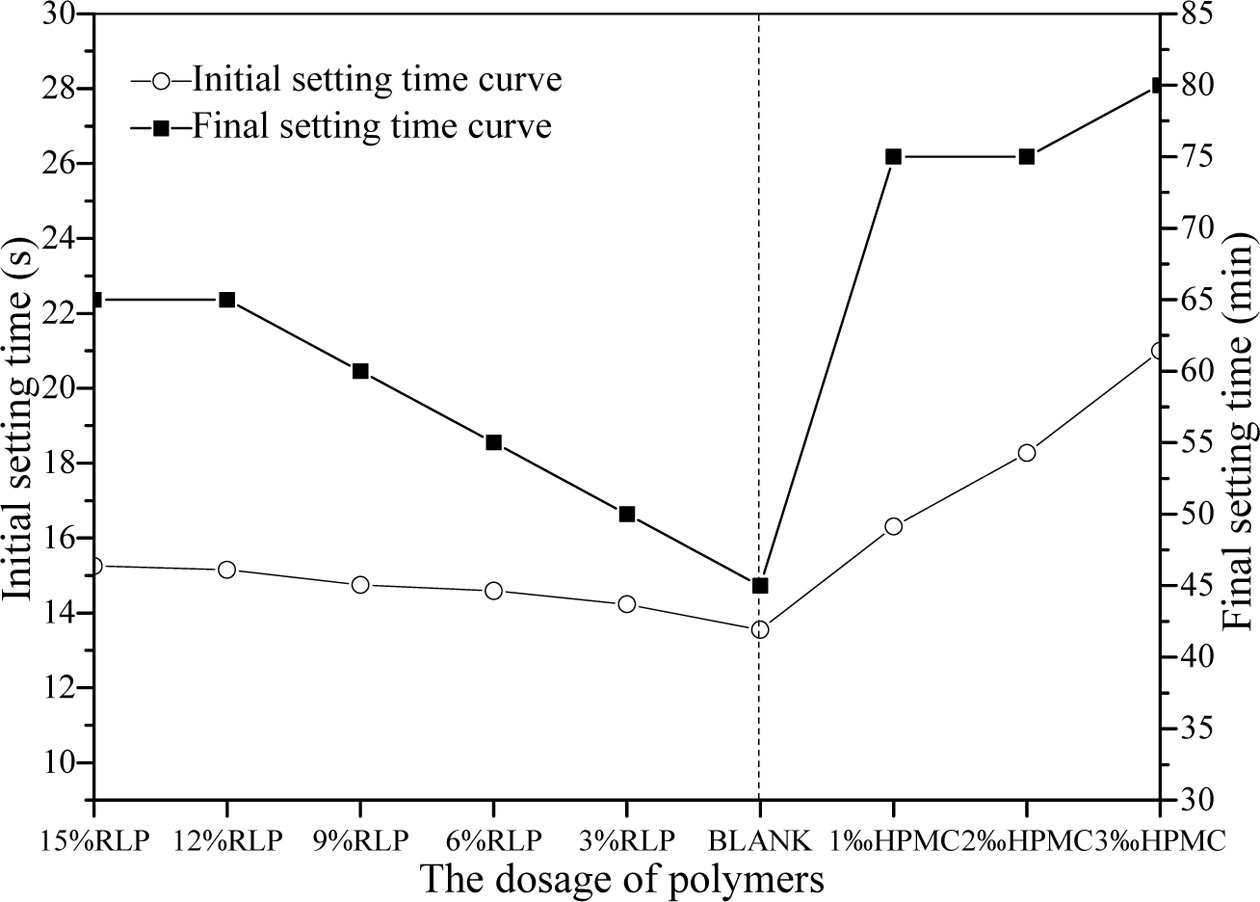
|
Fig. 4 The setting times of grouts. |
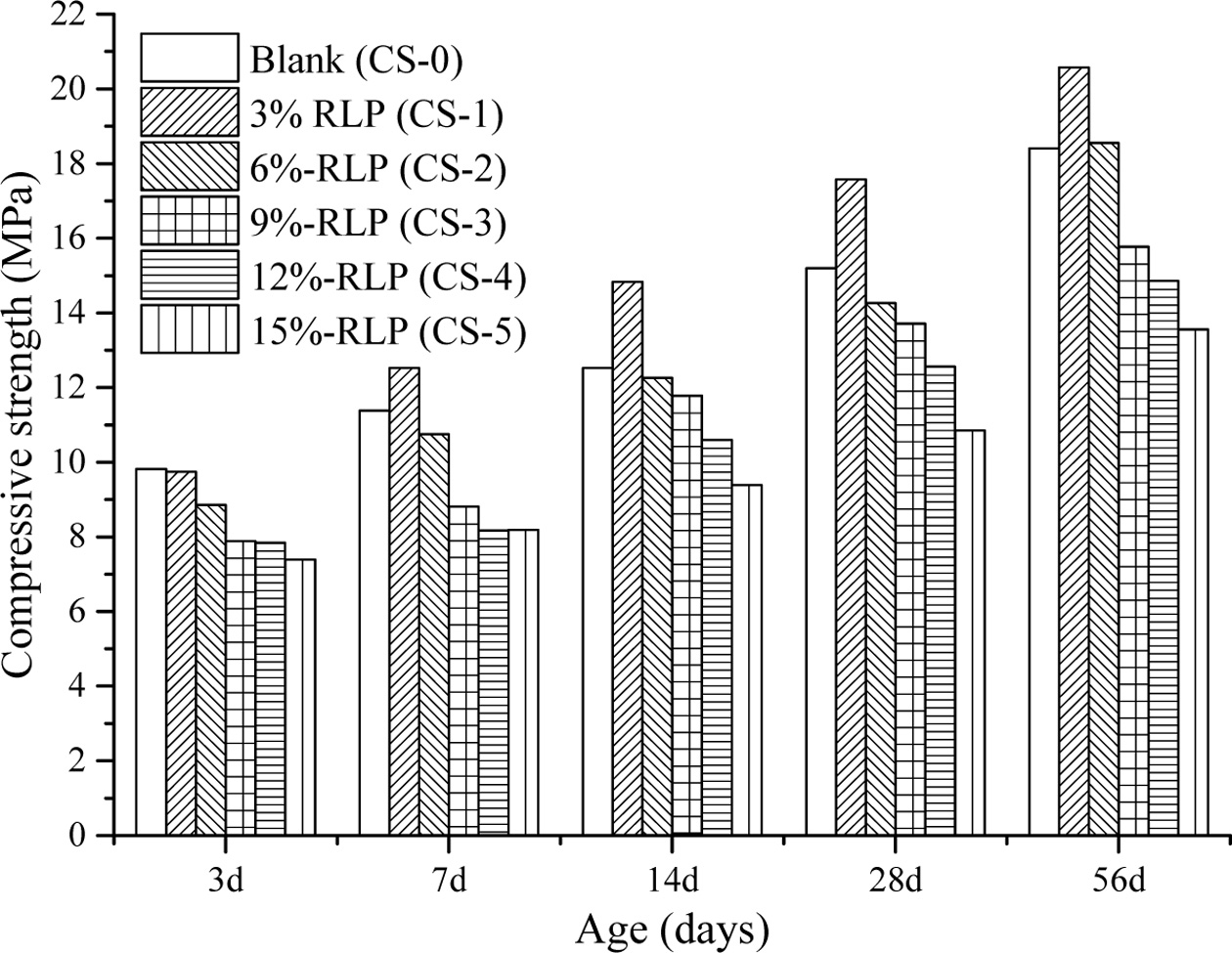
|
Fig. 5 Compressive strengths of specimens with different amounts of RLP. |
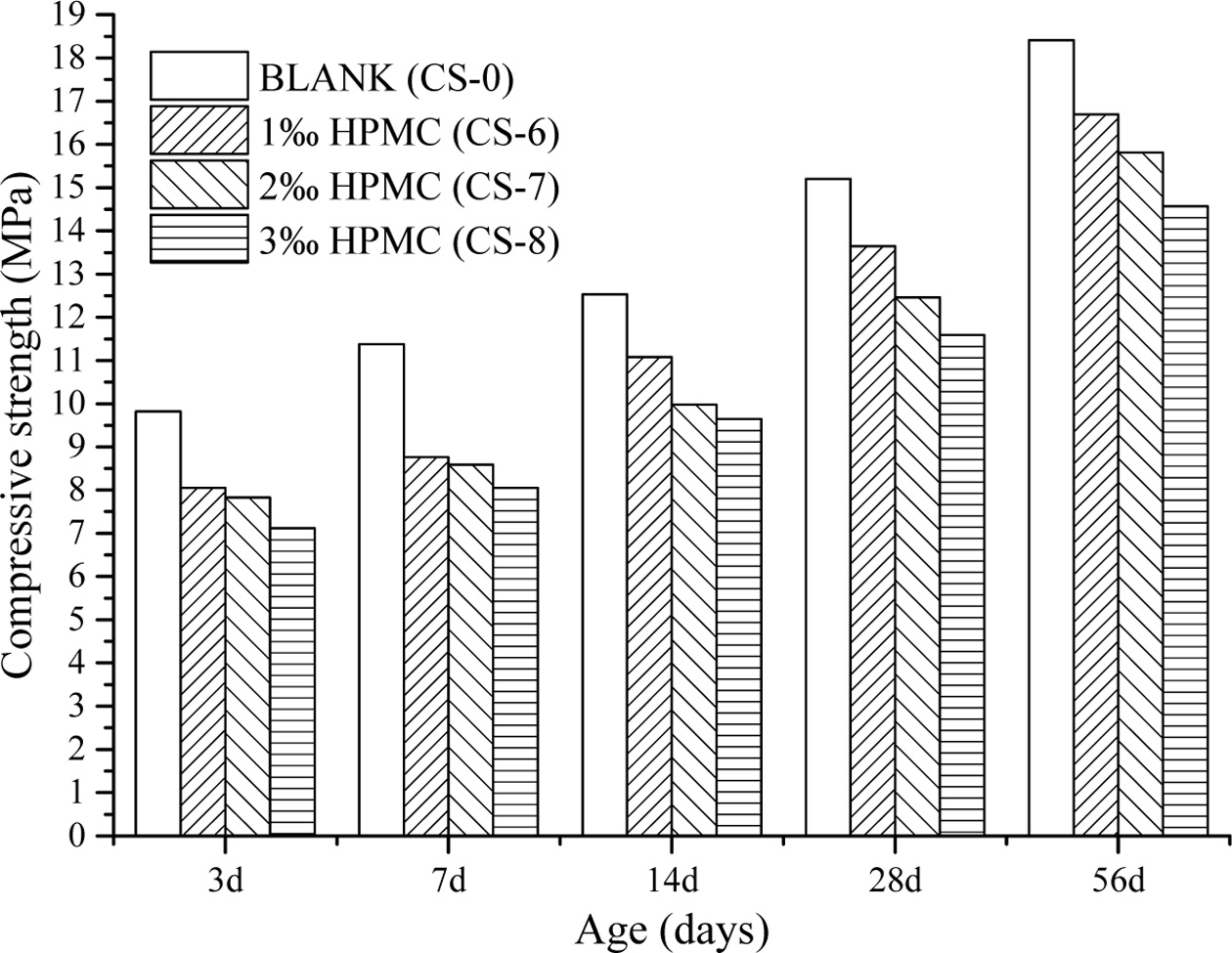
|
Fig. 6 Compressive strengths of specimens with different amounts of HPMC. |
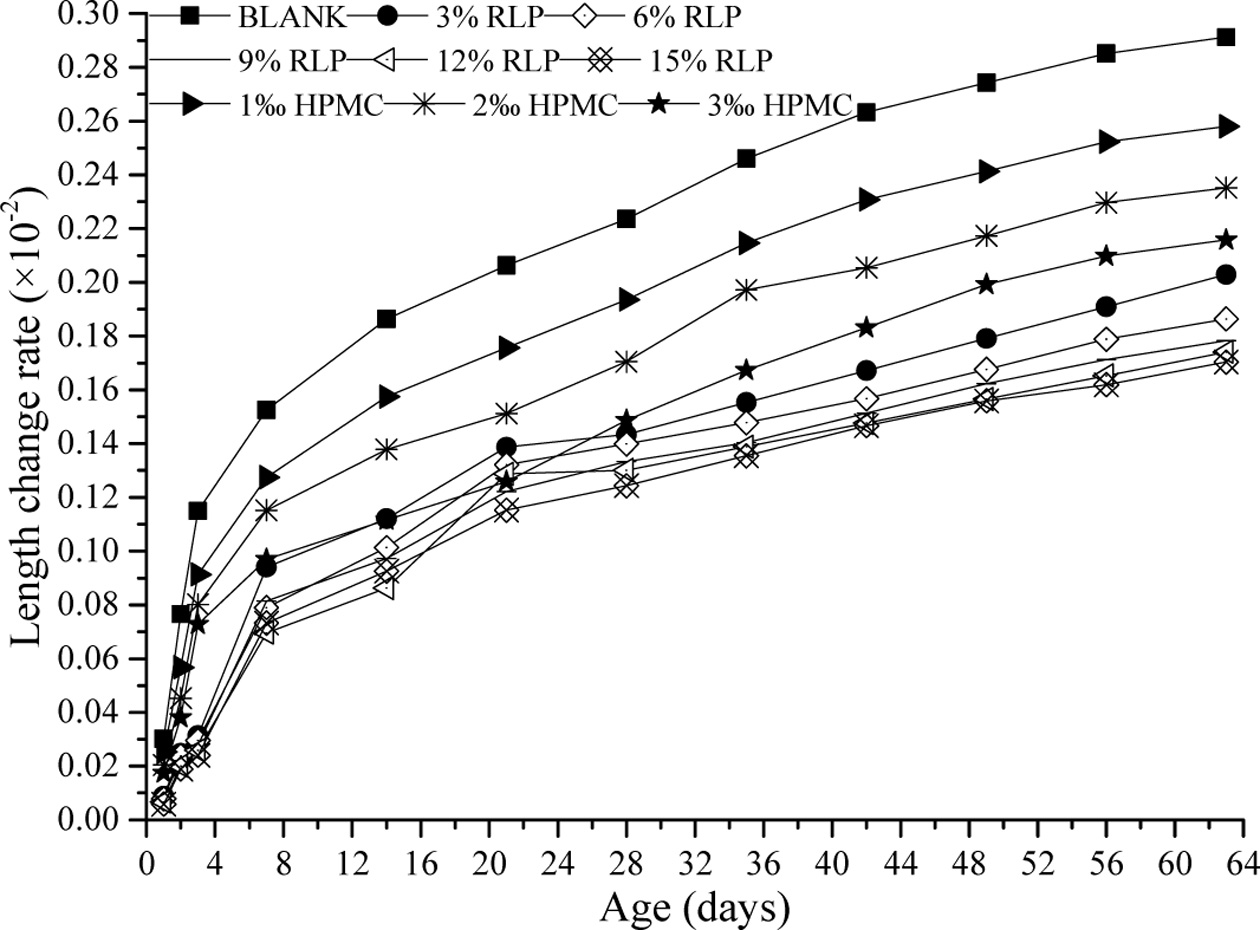
|
Fig. 7 The autogenous shrinkage characteristics of grouts. |
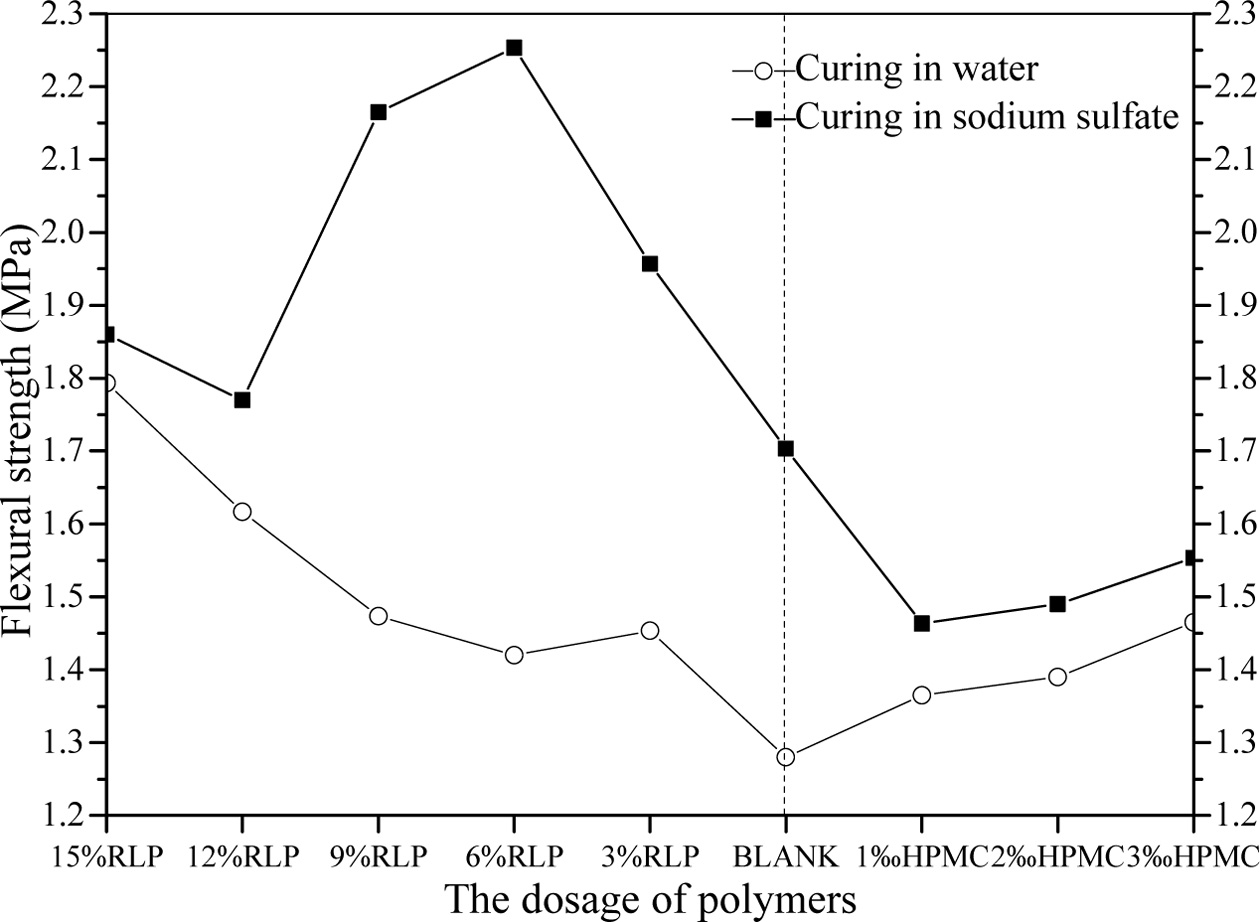
|
Fig. 8 The 28 d flexural strength after curing in water and sodium sulfate with 3 wt%. |
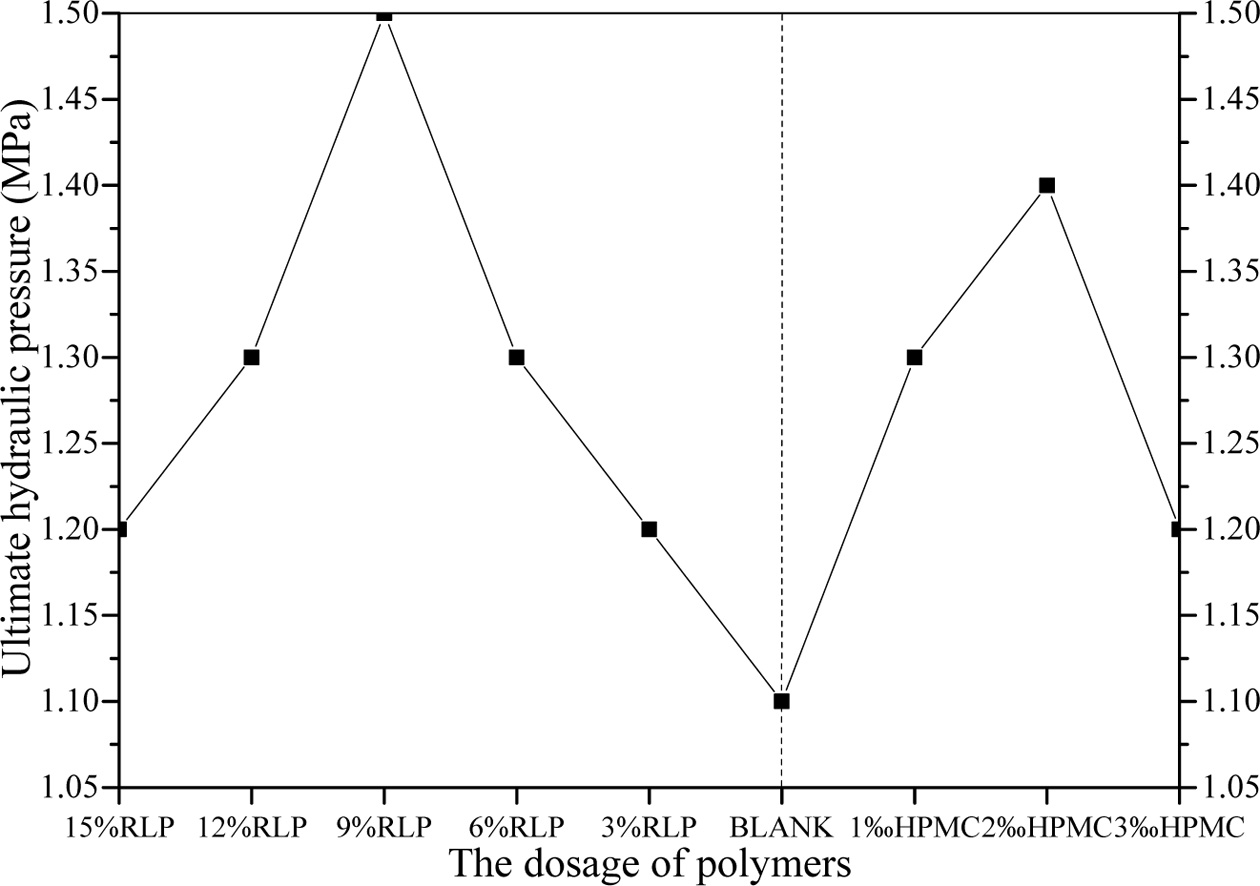
|
Fig. 9 The ultimate hydraulic pressure of the grouts at 28 d. |
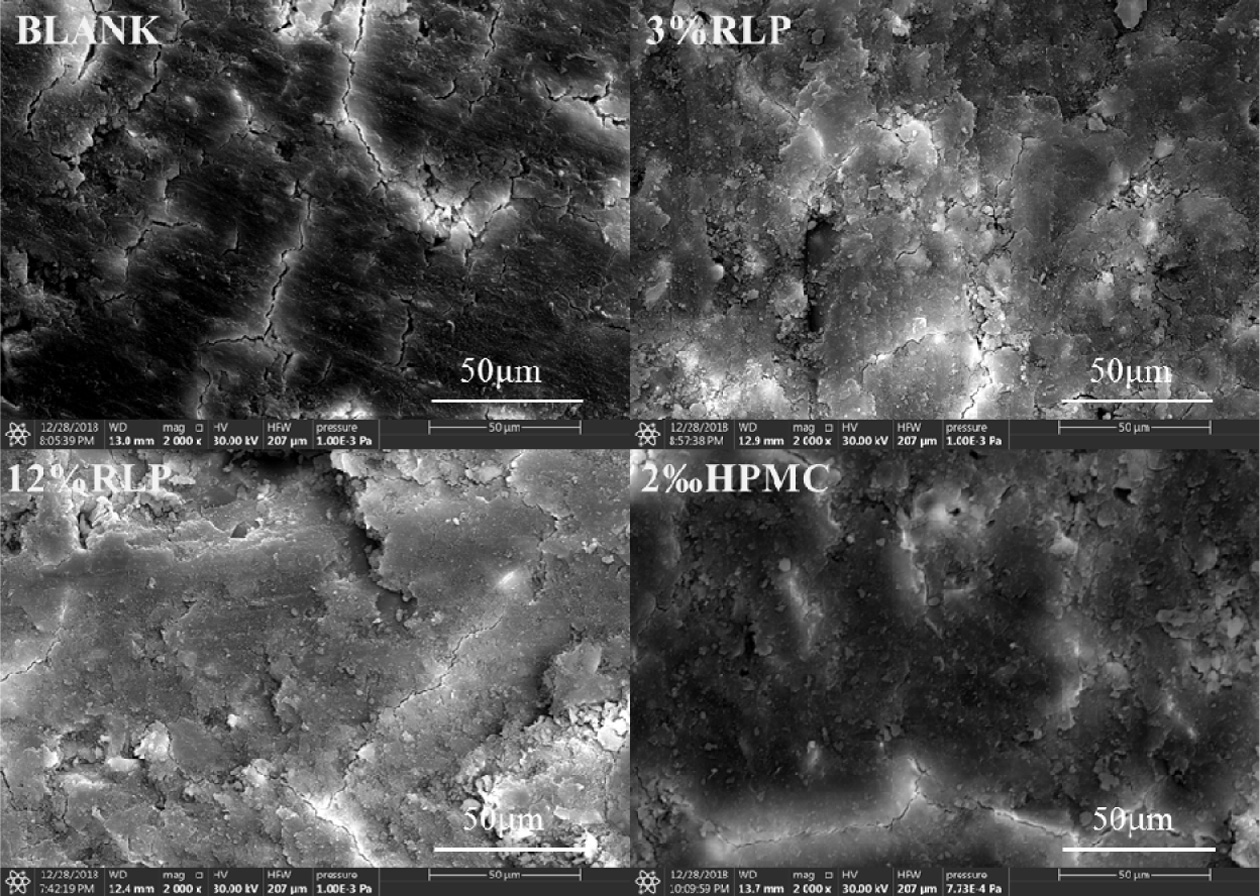
|
Fig. 10 Micrographs of specimens under a magnification of 2000 times. |
This paper mainly studies the influence of RLP and HPMC on
the physical and mechanical properties of CS grouts with a high W/B ratio. With
the variation of mixing amounts of polymers, the rheological
properties, setting time, compressive strength,
autogenous shrinkage, sulfate attack resistance and permeability are
tested and assessed. The main conclusions are summarized as follows:
(1) The yield stress and plastic viscosity of the cement
slurry incorporating RLP and HPMC increased significantly, which would be
beneficial for improving the resistance to dispersion in water.
(2) The effect of HPMC on CS grout setting time was better
than that of RLP. The initial setting time was prolonged by 20~55%, and the
final setting time was prolonged by 67~78%. These time could provide references
for grout material selection in the grouting project.
(3) The reduction of autogenous shrinkage was more
significant when RLP was incorporated into CS grouts. The addition
of the two polymers significantly inhibited the
formation of new cracks.
(4) Although two polymers had a negative impact on the
compressive strength of CS grouts except for the RLP content
of 3%, they increased the flexural strength. CS grouts
with the proper amount of RLP had a superior sulfate attack
resistance when exposed to sulfate-rich environments.
(5) The ultimate hydraulic pressure increased 0.1–0.4 MPa
when RLP and HPMC were incorporated into CS grouts. The durability under a
certain underground water pressure was improved.
The authors are thankful for the financial support
provided by the National Natural Science Foundation of China (51979153) and
Shandong University from Project Entrusted by Enterprises and Public
Institutions (11441655).
- 1. W. Cui, J. Huang, H. Song, and M. Xiao, Constr. Build. Mater. 156 (2017) 184-198.
-

- 2. M.R. Azadi, A. Taheri, and A. Taghichian, J. Rock. Mech. Geol. Eng. 9[4] (2017) 623-637.
-

- 3. D. Ravikumar and N. Narayanan, Cement. Concrete. Comp. 44 (2013) 58-68.
-

- 4. H.J. Dou, in “Investigation on the performance and microscopic characteristics of complex cementitious-sodium silicate two-shot grouting materials” (China University of Geosciences, 2014) p.1.
- 5. S.Z. Liu, in “Experimental study on mechanical properties of cement sodium silicate slurry under salt erosion” (Hunan University of Science and Technology, 2016) p.1.
- 6. P. Tu, in “Durability experiment and evaluation theory of grouting concretion stone” (Central South University, 2012) p.2.
- 7. J.K. Yang, H.J. Lu, J.X. Li, and D.F. Zhu, Journal of Dalian University of Technology. 56[3] (2016) 252-256.
- 8. F. Chen, B.L. Huang, M.F. Ba, and X.D. Bao, Acta Mater. Compositae Sin. 30[6] (2013) 139-145.
- 9. M.Y. Wu, Q.C. Wang, R.L. Zhang, H.X. Tian, K. Zhang, and X.L. Wang, Bull. Chin. Ceram. Soc. 35[09] (2016) 2741-2746.
- 10. Q.W. Guo, X.B. Yin, Y.J. Chen, and X.F. Wan, J. Chongqing Jiaotong Univ. 34[01] (2015) 40-43.
- 11. Y.J. Chen and X.F. Wan, Bull. Chin. Ceram. Soc. 33[07] (2014) 1846-1851.
- 12. FH. Heukamp, FJ. Ulm, and JT. Germaine, J. Mater. Civ. Eng. 17[3] (2005) 307-312.
-

- 13. J.-S. Ryu, N. Otsuki, and H. Minagawa, Cement. Concr. Res. 32[10] (2002) 1539-1544.
-

- 14. Z. Yu, L.C. Yang, S.H. Zhou, Q.M. Gong, and H.B. Zhu, Constr. Build. Mater. 189 (2018) 550-559.
-

- 15. Y. Ohama, Cement Concrete Comp. 20[2] (1998) 189-212.
- 16. X.L. Han, X.M. Chen, H.Z. Jiao, G.D. Sun, and T.F. Dong, Bull. Chin. Ceram. Soc. 37[08] (2018) 2457-2462.
- 17. W. Zhao, D.X. Li, and Q.H. Li, Materials Review: Review article. 24[06] (2010) 136-140.
- 18. P.M. Wang, G.R. Zhao, and G.F. Zhang, J. Chin. Ceram. Soc. 46[02] (2018) 256-262.
- 19. H.X. Zhao, T.F. Hua, X.J. Ma, and H. Zhou, Concrete. 6 (2015) 121-123.
- 20. J.-B. Lee, S.-H. Park, and S.-S. Kim, J. Ceram. Process. Res. 18[3] (2017) 220-229.
- 21. W.J. Ruan, Chin. J. Rock Mech. Eng. 24[15] (2005) 2709-2715.
- 22. Z.H. Ou, B.G. Ma, and S.W. Jian, Bull. Chin. Ceram. Soc. 31[1] (2012) 96-98.
- 23. J. Do and Y. Soh, Cem. Concr. Res. 33[10] (2003) 1497-1505.
-

- 24. J.H. Peng, J.B. Mao, J.X. Zhang, J.D. Qu, and C. Teng, Bull. Chin. Ceram. Soc. 30[04] (2011) 915-919.
- 25. M.R. Zhou and W.H. Zhang, Concrete. 6 (2007) 71-73.
- 26. K. Liu, L. Mo, M. Deng, and J. Tang, Adv. Cem. Res. 27[8] (2015) 477-486.
-

 This Article
This Article
-
2020; 21(4): 393-399
Published on Aug 30, 2020
- 10.36410/jcpr.2020.21.4.393
- Received on Sep 6, 2019
- Revised on Mar 9, 2020
- Accepted on Jun 29, 2020
 Services
Services
- Abstract
introduction
experimental materials and methods
results and discussion
conclusion
- Acknowledgements
- References
- Full Text PDF
Shared
 Correspondence to
Correspondence to
- Lei Yang
-
Geotechnical & Structural Engineering Research Center, Qianfoshan Campus, Shandong University, Lixia District, Jinan City, Shandong Province, China
Tel : +86 0531-88399712
Fax: +86 0531-88395984 - E-mail: yanglei@sdu.edu.cn








 Copyright 2019 International Orgranization for Ceramic Processing. All rights reserved.
Copyright 2019 International Orgranization for Ceramic Processing. All rights reserved.